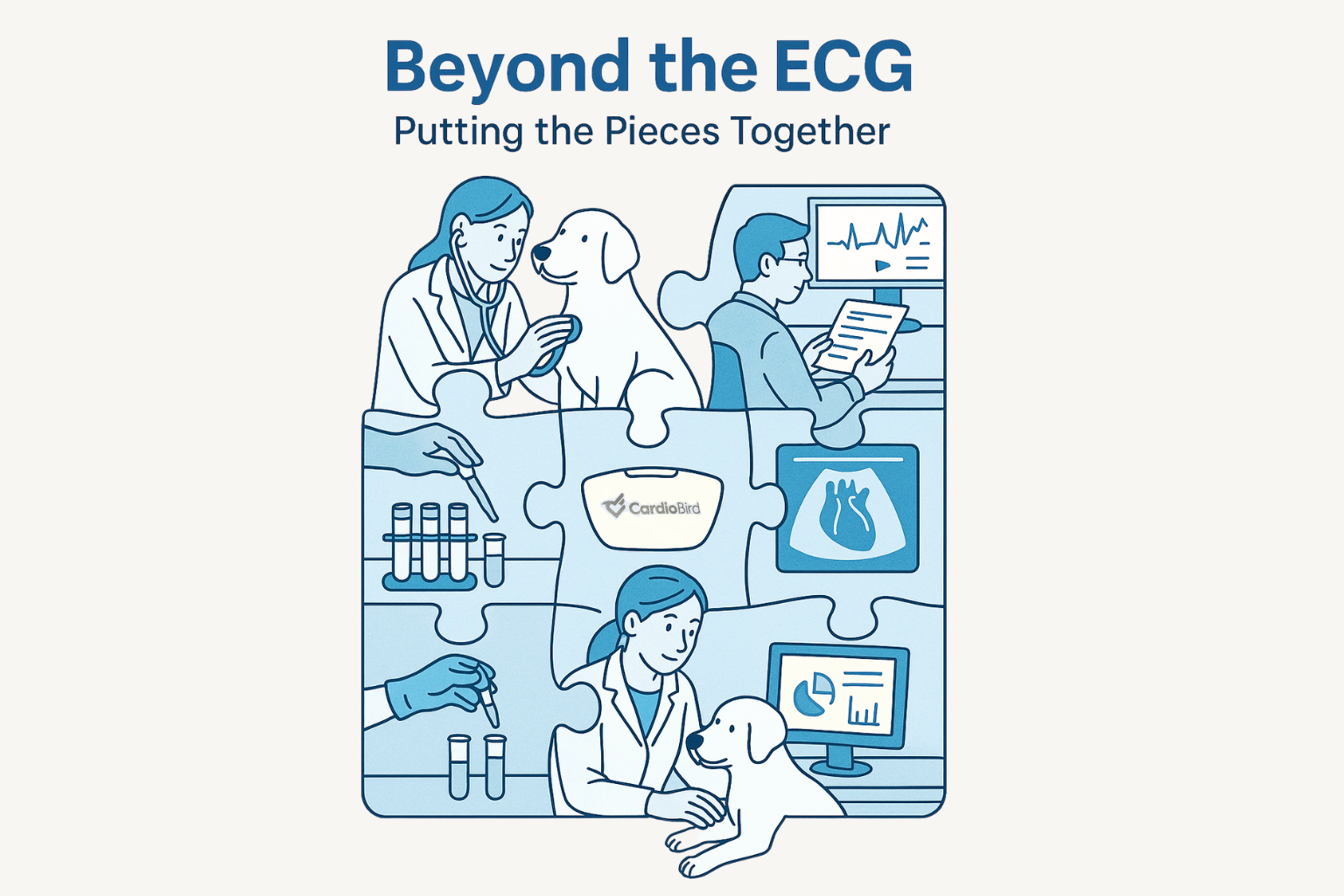Beyond the ECG: Putting the Pieces Together for a Complete Cardiac Picture
Estimated reading time: 3.55 minutes

As primary care veterinarians, you’re often the first line of defense in identifying and managing cardiac issues in your patients. While the CardioBird ECG provides valuable insights into the electrical activity of the heart, it’s crucial to remember that it’s just one piece of the puzzle. Integrating ECG findings with other diagnostic tools is essential for accurate diagnosis, effective treatment planning, and improved patient outcomes. This article will guide you on how to seamlessly incorporate CardioBird ECG results into your existing workflow, alongside physical exam findings, blood pressure measurements, biomarkers, and imaging.
1. The Power of the Physical Exam
Before even reaching for the ECG, a thorough physical exam can provide crucial clues. Pay close attention to:
- Auscultation: Murmurs, arrhythmias, and gallop sounds can indicate underlying structural or functional heart disease. Remember that not all murmurs are created equal – location, timing, and intensity can provide valuable information. A grade III or higher murmur warrants further investigation.
- Pulse Quality: Weak or irregular pulses may suggest arrhythmias, poor cardiac output, or peripheral vascular disease. Compare femoral and dorsal pedal pulses for discrepancies.
- Respiratory Rate and Effort: Increased respiratory rate (tachypnea) or effort (dyspnea) can be signs of congestive heart failure (CHF) or other respiratory conditions.
- Mucous Membrane Color and Capillary Refill Time (CRT): Cyanosis (blue gums) indicates poor oxygenation, while prolonged CRT (>2 seconds) suggests poor perfusion.
- Jugular Venous Distention: Suggests increased central venous pressure, often associated with right-sided heart failure.
- Ascites or Peripheral Edema: These can be signs of fluid retention due to heart failure.
2. Blood Pressure: A Vital Sign
Hypertension in animals is often caused by systemic diseases such as Cushing’s syndrome, chronic illnesses, and diabetes. This condition can exacerbate heart disease. It is important to monitor blood pressure, particularly in older animals and those with known systemic or heart diseases.
3. Biomarkers: NT-proBNP and Beyond
Cardiac biomarkers like NT-proBNP (N-terminal pro-B-type natriuretic peptide) can help differentiate between cardiac and non-cardiac causes of respiratory distress or other clinical signs. Elevated NT-proBNP levels suggest myocardial stretch and are highly sensitive for detecting moderate to severe heart disease, particularly in cats. Remember that NT-proBNP is a screening tool and not a definitive diagnostic test.
4. Chest Radiography: Visualizing the Heart and Lungs
Chest X-rays provide valuable information about heart size and shape, as well as the presence of pulmonary edema or pleural effusion. Assess the vertebral heart score (VHS) to objectively evaluate heart size. Look for signs of left atrial enlargement or compression of the bronchia.
Putting It All Together: Integrating CardioBird ECG Results
Now, how does the CardioBird ECG fit into this picture? Here are some examples:
- Murmur + Arrhythmia on Auscultation + Elevated NT-proBNP + Cardiomegaly on Radiographs + Atrial Fibrillation on ECG: This constellation of findings strongly suggests advanced heart disease, such as dilated cardiomyopathy (DCM) or mitral valve disease.
- Normal Physical Exam + Normal Blood Pressure + Normal NT-proBNP + Sinus Tachycardia on ECG: This may be a normal response to stress or excitement, but consider hyperthyroidism or pain as possible underlying causes.
- Coughing + Dyspnea + Normal NT-proBNP + Pulmonary Infiltrates on Radiographs + Normal Sinus Rhythm on ECG: This is more likely to be a primary respiratory problem, such as pneumonia or bronchitis.
Integrating ECG into Your Workflow:
- Signalment and History: Start with a thorough history and signalment (age, breed, sex). Certain breeds are predisposed to specific cardiac conditions.
- Physical Exam: Perform a complete physical exam, paying close attention to the cardiovascular and respiratory systems.
- Initial Diagnostics: Based on your initial assessment, consider blood pressure measurement, NT-proBNP testing, and chest radiographs.
- CardioBird ECG: Use the CardioBird ECG to evaluate heart rate, rhythm, and conduction abnormalities† .
- Interpretation: Correlate the ECG findings with the other diagnostic results.
- Further Diagnostics (if needed): If the diagnosis is unclear, consider referral to a veterinary cardiologist for echocardiography or other advanced testing.
Conclusion:
By integrating CardioBird ECG results with other diagnostic tools and clinical findings, you can provide comprehensive cardiac care to your patients. Remember to consider the whole picture, not just a single test result. With a systematic approach, you can confidently diagnose and manage cardiac disease in your primary care practice, improving the quality of life for your patients and strengthening the bond with their owners.
† Keep in mind that a normal ECG does not exclude all forms of heart disease. Some structural abnormalities may not be evident on ECG, particularly in early stages.

